Our lab has a broad interest in biology encompassing the fields of natural selection theory, genetics, population and community ecology, and conservation biology. However, we use two systems as microcosms to study a range of phenomena that fascinate us, such as morphological evolution, sexual dimorphism, geographical distribution of animals, and speciation. The first is Batesian mimicry, which is a mechanism by which unprotected prey species gain protection from predators by their resemblance to protected (e.g., toxic) species. The second system is Indian butterflies, which, with ca 1,400 species distributed in an interesting geographical mosaic, offer virtually unlimited opportunities to study biodiversity, biogeography, community ecology, population biology and conservation issues. Summaries of our major research projects are given below, and further information on linked pages.
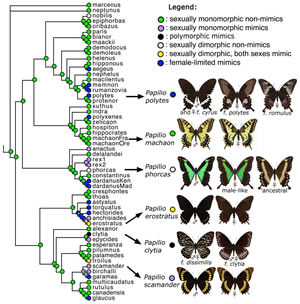
Diversity and Evolution of Batesian Mimicry: The magnificent diversity of Batesian mimicry is manifested in several sex-limited and polymorphic types. This offers an excellent system to study natural, sexual and frequency-dependent selection that shapes the evolution of sex-limited traits and polymorphism. However, currently there is little understanding of how this diversity is distributed among species, and why different mimicry types are favored. To answer these questions, we have developed: (a) a mathematical model of the selection regimes under which various mimicry types may be favored, and (b) a graphical model of the evolution of mimicry types to study character state changes within a phylogenetic framework. We are testing these models with data on the Eastern Himalayan and Western Ghats butterfly "mimicry rings", and by analyzing evolution of mimicry types on a molecular phylogeny of Papilio swallowtail butterflies. Read more ...
Wing Color Pattern Evolution, Mimicry, and Speciation in Papilio Swallowtail Butterflies: Mormon swallowtails (subgenus Menelaides) make up a diverse group of Papilio with ca 50 species distributed over the Indo-Australian Region. The geographic mosaic of their distributional ranges, endemism and diversification in regional hotspots, and subspeciation at sometimes micro-spatial scales make them a promising group for studying biogeographic processes and speciation. Many of them also show a spectacular diversity of Batesian mimicry and wing patterns. Read more ...

Molecular Genetics and Evolution of Mimicry in the Papilio polytes Butterfly: Papilio polytes, a widely ranging Asian swallowtail, has a single non-mimetic male form and several female forms, most of which mimic locally abundant toxic Pachliopta butterflies. We are studying this female-limited mimetic polymorphism in P. polytes to understand the molecular genetic basis of sexual dimorphism and polymorphism. We are also aiming to understand what kind of genetic changes enable major switches between wing color patterns in butterflies, and what selective pressures favor their evolution. We are studying these factors at the continental scale, covering the entire Oriental Region. This is interesting because P. polytes is a regionally variable species in which some female forms occur in some populations but not others. This offers an opportunity to study local adaptation and compare genomic backgrounds on which wing patterns and their genetic bases have evolved. Furthermore, there is genetic dominance hierarchy between the female forms, the non-mimetic female form being recessive to all the mimetic female forms. Thus, we also study the basis and nature of genetic dominance. Read more ...

Ecology, Biogeography, Phylogenetics and Conservation of Indian butterflies: One of the long-term goals of our lab is to study the ecology and patterns of diversification, endemism and evolution of Indian butterflies. Migration, seasonal population dynamics, biogeography, phylogeography, community structure and mimicry are some of the areas in which we have several ongoing projects. We have started a modern research collection of Indian butterflies, with associated geo-referenced data and DNA library, which we are using for our taxonomic, phylogenetic, phylogeographic, conservation genetics and conservation prioritization work on Indian butterflies. We are also spear-heading the development of a continually updated and expanding website on Indian butterflies. Read more ...
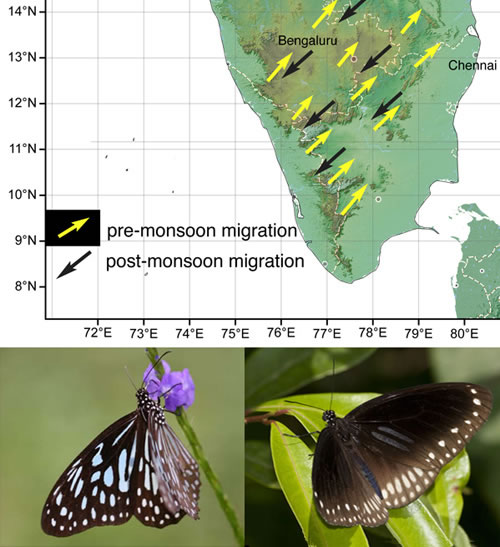
Population Biology of Butterfly Migrations, and its Evolutionary and Genetic Consequences: A spectacular natural event takes place across southern India every year: millions of butterflies migrate from the Sahyadri (also known as the Western Ghats) to the eastern plains around May, and a reverse migration takes place in October or November. These migratory swarms may contain half a dozen species, but are overwhelming dominated by two: Tirumala septentrionis dravidarum (Dakhan Dark Blue Tiger) and Euploea sylvester coreta (Double-branded Black Crow) (Nymphalidae: Danainae). This migration is quite fascinating because: (a) it is longitudinal (east-west), not latitudinal (north-south) or altitudinal like most other well-known migrations, and (b) it seems to be driven by the Indian monsoon, not by cold or drought, as is the case in many other migrations. We are currently investigating how the Indian monsoon influences population biology of these butterflies, and what are the evolutionary and genetic consequences of migratory behavior. Read more ...
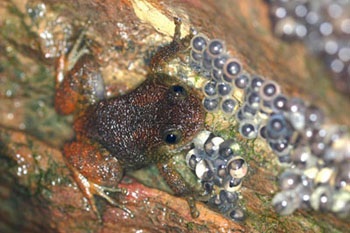
Mating System and Reproductive Behavior of Wrinkled Frogs: We study the wrinkled frog, Nyctibatrachus petraeus, which shows a unique combination of reproductive behaviors: (a) absence of amplexus, (b) resource-based male territoriality, (c) very small clutch size, (d) multiple mating by both males and females, (e) oviposition on vegetation outside water, without a foam nest, and (f) plastic development time that is sensitive to risk of predation. These behaviors show similarities with the Neotropical poison-dart frogs (Dendrobatidae), glass frogs (Centrolenidae) and red-eyed tree frogs (Agalychnis spp). This unique mating system makes it an attractive behavioral study system. Read more ...
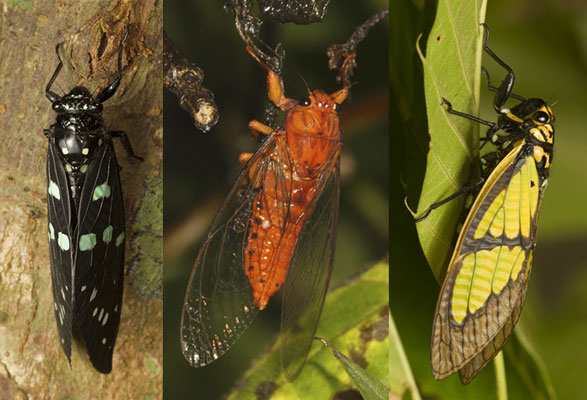
Evolution, Diversification and Biogeography of Cicadas on the Indian Subcontinent: India is at the junction of Palearctic and Oriental zoogeographic regions, and is believed to have been critical in the evolution and exchange of faunal elements between these zoogeographic regions. Thus, understanding the biogeography of Indian faunas is important in constructing a more complete picture of biological diversification in the Indo-Australian Region. Using cicadas, we aim to: (a) study the origin and diversification of cicadas in India in relation to neighboring regions, (b) generate a higher-level phylogeny of Indian cicadas that will form a backbone of further studies, and (c) inventory cicada diversity. Read more ...
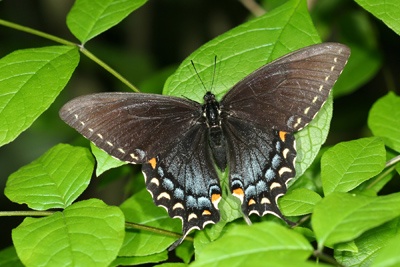
Hybrid Speciation and Mimicry in the Papilio glaucus Species Group: The North American Papilio appalachiensis butterfly is a hybrid species between P. glaucus and P. canadensis. It has a mix of morphological and phenological traits that are derived from its parental species: it shares its mimetic female form and sexual dimorphism with P. glaucus, whereas it has a single generation per year and obligatory diapause similar to P. canadensis. The mixed phenotype of P. appalachiensis results from mosaicism at its sex chromosomes. We are using molecular genetic approaches to investigate the evolutionary history of P. appalachiensis to understand the evolutionary dynamics and genetics of hybrid speciation in animals. Read more ...

Diversity and Structure in Nectar-feeding Butterfly Communities (June-August 2003): This was an experimental ecological study investigating effects of competition and invasive species on the diversity, community structure and foraging behavior of nectar-feeding butterflies. We carried out this study at Corcovado National Park, Costa Rica. The system consisted of over three dozen species of butterflies feeding mainly on Lantana and Wedelia. The butterfly community was numerically dominated by two species of Anartia butterflies. After experimentally removing Anartia, diversity in this butterfly community increased two-fold, influencing community structure. Read more in Kunte 2008 (Oikos; PDF file) and Kunte 2007 (Functional Ecology; PDF file).

Biodiversity Conservation in India: India is one of the world's most biodiverse countries, and also the world's second-most populous country with a very large population of rural and urban poor. Moreover, it has ambitions to become a major industrialized nation. If we are to conserve biodiversity in the Indian Region, we need a better understanding of how biodiversity has evolved in this complex natural landscape, how it is affected by human history and modern progress, and how its loss will contribute towards degradation of the quality of life and economic growth in India. Read more ...
You can read about our work that is not covered in the research outlines above by checking through our academic publications, and The age of exploration, discovery and excitement continues ... pages.
We are always open to new, exciting ideas and to scientific collaborations, so please contact us if contents on this page, or biological sciences in general, are of interest to you.